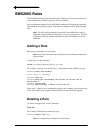
IP Addressing
TUT Systems, Inc Page 72 of 104 P/N 220-06288-20
Configuring a Control Network for
Additional Client IP Addresses
Note: This command is only required when using DHCP or static IP addresses
on a physical network with multiple IP subnets, and the administrator wants
subscribers to be allocated DHCP or static addresses from these additional IP
subnets.
To configure a control network for additional client IP addresses, use this command:
control-net [delete] {ip_address netmask ip_mask | ip_address/masklen |
start-address end-address ip_mask}
For example, to set a control-net network, type:
sms2000% control-net 192.168.20.100 192.168.20.100
255.255.255.255
For example, to delete a control-net network, type:
sms2000% control-net delete 192.168.20.100 192.168.20.100
255.255.255.255
Understanding 1to1 and 1to1 Unique IP
Types
Note: Ip types 1to1 and 1to1 unique are helpful in responding to Digital
Millennium Copyright Act (DMCA) complaints regarding subscribers sharing
copyrighted material illegally because they allow you to quickly isolate the
specific subscriber illegally sharing the copyrighted material. However, because
complaints may be filed well after a subscriber has disconnected, accounting
records indicating which subscriber used which IP address at which time must
be kept using either Syslog accounting, RADIUS accounting, or both.
When you configure group members for 1to1, unique addresses are assigned for each
session from a pool of source-net addresses. These addresses are used to determine which
session incoming packets (from the WAN) belong. The source port number of a 1to1
session is sent without port mapping to the destination.
Every subscriber uses a unique source-net address. When all of the addresses in a source-
net pool are in use and additional subscribers try to connect:
• 1to1 reverts to normal NAT (port mapped).
• 1to1 unique does not allow a new session.
Configuring IP Types
To configure the IP type for members of the active/current group, use the following
command:
iptype {default | NAT | static | DHCP | 1to1 | 1to1Unique}


















